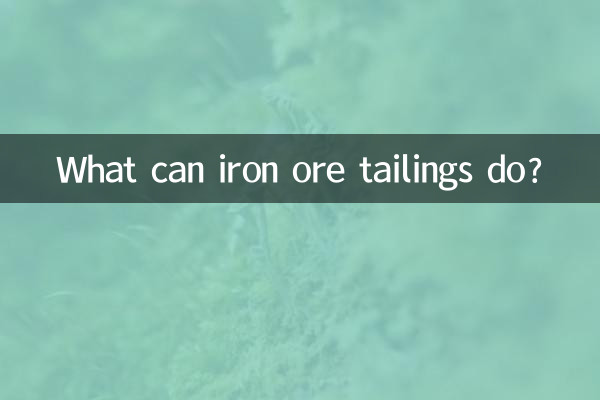What can be done with iron ore tailings? Explore new ways to utilize resources
In recent years, with the improvement of environmental awareness and the increasing demand for resource recycling, the treatment and reuse of iron ore tailings has become a hot topic. Iron ore tailings are waste generated during iron ore mining and beneficiation. The traditional treatment method is often stockpiling, which not only occupies land but may also cause environmental pollution. However, with technological advancement, the potential value of iron ore tailings is gradually being tapped. This article will combine the hot content of the entire network in the past 10 days to explore the diversified utilization methods of iron ore tailings, and display relevant cases with structured data.
1. Current status and challenges of iron ore tailings

According to the latest statistics, my country produces more than 500 million tons of iron ore tailings every year, and the cumulative stockpile has exceeded 10 billion tons. How to efficiently utilize these tailings has become a key issue for the sustainable development of the mining industry.
| project | data | source |
|---|---|---|
| annual production | More than 500 million tons | China Mining Association |
| Cumulative inventory | More than 10 billion tons | Ministry of Natural Resources |
| Comprehensive utilization rate | about 20% | 2023 Industry Report |
2. Ways to reuse iron ore tailings
1.Building materials production
Iron ore tailings are rich in silicon, aluminum and other components and can be used as admixtures or aggregates for cement and concrete. For example, a new environmentally friendly brick produced by a building materials company using tailings has a compressive strength of more than 15MPa and has received good market response.
| Application areas | Technical indicators | Typical cases |
|---|---|---|
| cement admixture | Replacement rate 10%-30% | A cement factory project in Hebei |
| Environmentally friendly bricks | Compressive strength ≥15MPa | A building materials company in Shandong |
2.Land reclamation and ecological restoration
By adding amendments, tailings can be used for soil improvement or directly as reclamation material. Through tailings reclamation technology in a mining area in Inner Mongolia, the vegetation coverage rate has increased from less than 10% to 60%.
3.High value-added product extraction
Some tailings contain valuable components such as rare earths and precious metals. The latest research shows that metals such as copper and gold can be recovered from specific tailings using bioleaching technology, with a recovery rate of more than 70%.
3. Policies and market dynamics
Recently, the National Development and Reform Commission issued the "Guiding Opinions on the Utilization of Solid Waste Resources", which clearly requires that the comprehensive utilization rate of iron ore tailings reach 35% by 2025. The capital market also responded quickly, with related concept stocks rising by an average of 12% in the past month.
| policy documents | core goals | Time node |
|---|---|---|
| "Guiding Opinions on Resource Utilization of Solid Waste" | Tailings utilization rate 35% | 2025 |
| "Green Mine Construction Specifications" | Mandatory tailings utilization plan | Trial in 2024 |
4. Future Outlook
With technological breakthroughs and policy promotion, iron ore tailings will transform from "waste" to "treasure". Experts suggest that the following work needs to be strengthened in the next step:
- Establish a tailings composition database to achieve accurate matching and utilization
- Promote the "on-site conversion" model to reduce transportation costs
- Improve tax incentives and other incentive mechanisms
The resource utilization of iron ore tailings is not only an environmental protection requirement, but also a new industrial opportunity. Through technological innovation and model optimization, this "urban mine" will surely release huge value.

check the details

check the details